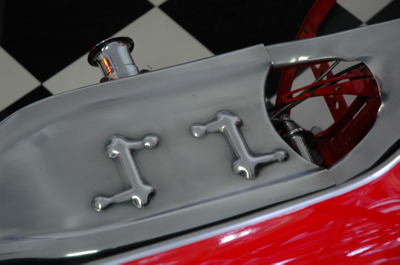Mr. Jalopy of Hooptyrides showed me this beautiful design detail he shot of Burt Munro’s famous Indian motorcycle record breaker. The same motorcycle featured in Roger Donaldson’s wonderful movie The World’s Fastest Indian. I quite liked that flick, especially the opening sequence, which is a perfect balance of deep technical unabashed gearhead gnarlyness and man-on-the-street, just-tell-me-a-simple-story plot exposition.
Just look at it. Those two "seahorse" details in the metal plate are there to provide mechanical clearance for the furiously revolving rocker arms on the little terror of a motor found beneath. You can just see the intake trumpet in the background, poking its snout out like a shy little elephant. Burt Munro was an incredible innovator. This is stunning design work. I can’t help but agree with Mr. Jalopy when he says that "…I am not even particularly interested in motorcycles, but I spent half
an hour looking at this amazing machine and kept finding trick shit
like this. I don’t know that I have seen a greater accomplisment by a
single person."
The more I look at it, the more I feel there’s a wealth of insight to be found in this photo about the process, philosophy, and value of design thinking. I’m going to keep writing about Burt Munro’s rocker divots for a while, just to see what’s there. I’d like to hear what you see, too.


So, Diego, let me understand this. The “seahorse” element is actually functional in that it permits valve rockers the space they need to open and close? Rather than raising the level of the whole case, Munro did this design detail? If my understanding is correct that’s very, very cool.
Hi Tom,
I haven’t actually seen the bike in person, but Mr. Jalopy has, and he says they’re there for clearance. The shape and orientation of the “seahorses” leads me to the same conclusion.
Cool, eh?
As Gordon Murray once said, it’s all about who has the lowest center of gravity.
really beautiful design, do you have more pics for it?